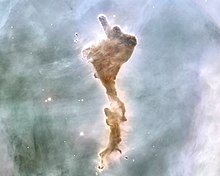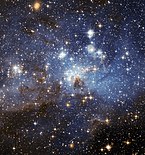
Back كرة بوك Arabic Глобула (астраномія) Byelorussian Глобула Bulgarian Glòbul de Bok Catalan Bokovy globule Czech Globule German Σφαιρίδιο Μποκ Greek Glóbulo de Bok Spanish Gloobul Estonian گلبول بوک Persian
| Bok globule | |
|---|---|
 The "finger of God" in the Carina Nebula | |
| Characteristics | |
| Type | Isolated Dark nebulae |
| Found | HII regions |
| Mass range | 2M☉-50M☉ |
| Chemical composition | Molecular hydrogen, carbon oxides, helium, and silicate dust |
| Size range | ~1ly |
| External links | |
| Additional Information | |
| Discovered | Bart Bok, 1940s |
| Star formation |
|---|
 |
| Object classes |
| Theoretical concepts |
In astronomy, Bok globules are isolated and relatively small dark nebulae containing dense cosmic dust and gas from which star formation may take place. Bok globules are found within H II regions, and typically have a mass of about 2[1] to 50 solar masses contained within a region about a light year or so across (about 4.5×1047 m3).[2] They contain molecular hydrogen (H2), carbon oxides and helium, and around 1% (by mass) silicate dust. Bok globules most commonly result in the formation of double- or multiple-star systems.[3]
- ^ Michael Szpir (May–June 2001). "Bart Bok's Black Blobs". American Scientist. Archived from the original on 2017-04-24. Retrieved 2008-11-19.
Bok globules such as Barnard 68 are only about half a light-year across and weigh in at about two solar masses
- ^ Clemens, Dan P.; Yun, João Lin; Meyer, Mark H. (March 1991). "BOK globules and small molecular clouds – Deep IRAS photometry and (C-12)O spectroscopy". Astrophysical Journal Supplement. 75: 877. Bibcode:1991ApJS...75..877C. doi:10.1086/191552.
- ^ Launhardt, R.; Sargent, A. I.; Henning, T.; Zylka, R.; Zinnecker, H. (10–15 April 2000). "Binary and multiple star formation in Bok globules". Birth and Evolution of Binary Stars, Poster Proceedings of IAU Symposium No. 200 on The Formation of Binary Stars. Potsdam, Germany: Bo Reipurth and Hans Zinnecker. p. 103. Bibcode:2000IAUS..200P.103L.
© MMXXIII Rich X Search. We shall prevail. All rights reserved. Rich X Search